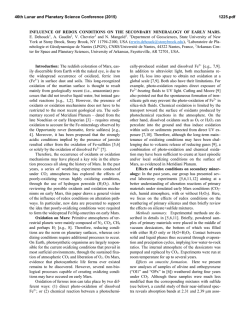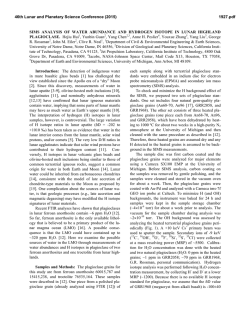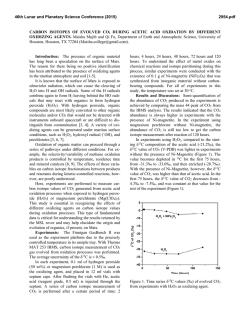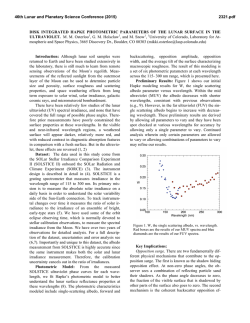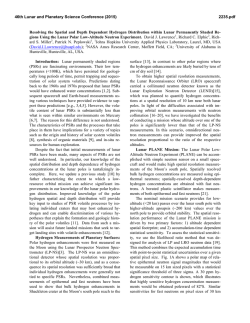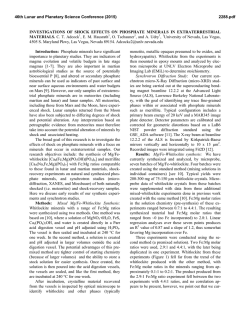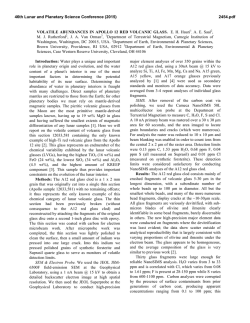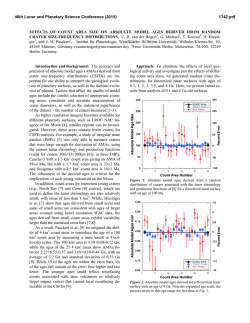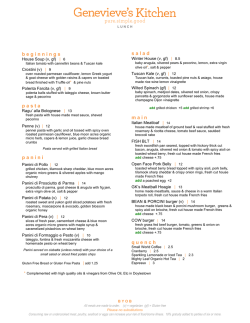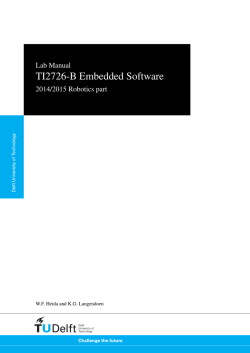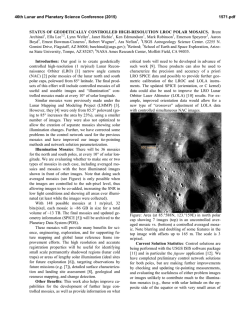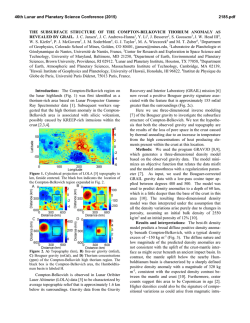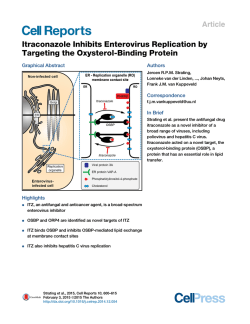
Reactive Oxygen Species Generation by Lunar Simulants
46th Lunar and Planetary Science Conference (2015) 1142.pdf REACTIVE OXYGEN SPECIES GENERATION BY LUNAR SIMULANTS. Jasmeet Kaur1,3,Martin A. Schoonen1,3, Douglas Rickman2, 1Department of Geosciences, Stony Brook University,Stony Brook-11794-2100 ( [email protected] and [email protected]); 2Earth Science Office, National Aeronautics and Space Administration, Marshal Space Flight Center, Alabama-35812([email protected]); 3RIS4E, Stony Brook University, NY 11794-2100. Introduction: The current interest in human exploration of the Moon and past experiences of Apollo astronauts has rekindled research into the harmful effects of Lunar dust on human health. While the mineralogical composition of lunar regolith has been well documented, other factors, such as partial melting due to space weathering, UV irradiation, and dryness may also contribute to the toxicity of lunar dust. For example, the presence of elemental iron “nano-particles” in agglutinatic material in the respirable size fraction has been recognized as a possible health concern[1]. Building on earlier work on mineral toxicity [2-5], we have started a research program focused on the reactivity of lunar dust in the context of inhalation exposures. As a first step, we have evaluated the generation of Reactive Oxygen Species (ROS) by several Lunar simulants. Background: ROS are chemically reactive molecules containing oxygen and include superoxide (O2•−), hydrogen peroxide (H2O2), and hydroxyl radicals (•OH). Previous studies have shown that mineral dust generates ROS when dispersed in water [6]. Minerals generate ROS either by surface defects or step-wise reduction of molecular oxygen. In the human body, ROS are produced by various endogenous systems and they play an important role in the normal functioning of cells. However, increased levels of ROS as a result of exposure to mineral dust can lead to oxidative stress, inflammation, genotoxicity (DNA damage) or apoptosis (programmed cell death) [7]. Methods: In the present work, we quantified H2O2 and • OH formation for a suite of different lunar simulants upon dispersion in water and simulated lung fluid (SLF). H2O2 was measured using a dedicated electrochemical probe providing real-time data, while •OH radical formation was determined in separate experiments using a spin trap technique followed by detection using Electron Spin Resonance (ESR) spectroscopy. In all H2O2 detection experiments in water we used EDTA to inhibit the Fenton Reaction, which converts H2O2 to •OH. If EDTA is not added, H2O2 concentraions are near or below the detection limit, presumably as a result of conversion to •OH. For ESR technique we used spin trap 5, 5-Dimethyl-1-pyrroline Noxide (DMPO) which forms a stable adduct with the unpaired electron. The intensity of adduct measured using ESR is directly proportional to •OH concentra- tion and was quantified using hydroxyl 2,2,6,6 tetramethylpiperidine (TEMPOL).We compared the reactivity of these simulants prepared in air and inert atmosphere. We also studied the effect of mechanical stress by hand crushing samples in a mortar and pestle. The effect of mechanical stress by crushing on the production of H2O2 was evaluated upto a period of nine days after the treatment. Sample Descriptions: JSC-1A is a volcanic ash from Merriam Crater, AZ. NU-LHT-2M is a complex mixture [8]. CSM-CL-S is milled from a scoria from +36° 49' 22", -104° 9' 17". OB-1 is a mixture of anorthosite from the Shawmere Anorthosite, Ontario, plus slag from a smelter near Sudbury, Ontario. ****-AGGL are made from the source simulant by Orbitec Technologies Corporation in a process that converts some of the material to agglutinate particles which contain nanophase-iron. Each of the source simulants were designed and milled to yield a specific, and similar, particle size distribution. Results: H2O2 detection experiments dispersed in water showed more H2O2 formation with simulants prepared in inert atmosphere than those prepared in air. Fresh crushed samples generated more H2O2 than uncrushed samples (see Fig. 1). The reactivity of fresh crushed samples decreased with time. For instance, in inert atmosphere, nine-day crushed JSC-1A generated 5µM of H2O2 while fresh crushed generated 10µM of H2O2. Similarly, nine-day crushed CSM-CL-S generated 120µM of H2O2 which was similar to the concentration generated by the uncrushed sample while two-day crushed sample generated 180µM (Fig. 2). Based on H2O2 detection experiments, JSC-1A, CSM-CL-S and OB-1 were found to be the most reactive of all simulants. ESR results with these three samples showed that fresh crushed JSC-1A and CSM-CL-S generated six times more •OH concentration compared to the uncrushed samples and fresh crushed OB-1 generated two and a half times more •OH compared to the uncrushed sample. The high reactivity of fresh crushed samples is likely due to the broken surface bonds. Pre-liminary H2O2 detection experiments in SLF showed continued generation of H2O2 for a period of about seven hours at a rate of 8.5µM/hr. This was in contrast to experiments in DI where H2O2 concentration after reaching a peak 46th Lunar and Planetary Science Conference (2015) value in about 10-20 minutes of reaction starts to decline. Figure 1: Comparison of H2O2 peak values of fresh crushed samples in air and N2 environment. Inset shows the peak values for uncrushed samples. Except for CSM-CL-S notice the low reactivity of uncrushed samples. Figure 2: Effect of mechanical stress on H2O2 formation by JSC-1A and CSM-CL-S in inert atmosphere. Notice the decrease in H2O2 with increase in treatment time. Future work: In a second phase, the effects of dehydrating simulants in vacuum and irradiation with UV will be evaluated. Also additional experiments will be conducted in simulated lung fluid to more closely match the chemical environment within the human lung. References: [1] Cain J.R.,(2010) Lunar Dust:The Hazard and Astronaut Exposure Risks. Earth Moon Planets 107:107-125. [2] Kamp D.W., Graceffa P, Pryor W.A., 1142.pdf Weitzman S.A. (1992) The role of free radicals in asbestos-induced diseases. Free Radic Biol Med 12:293315. [3] Rimal B, Greenberg A.K., Rom W.N. (2005) Basic pathogenetic mechanisms in silicosis: current understanding.Curr Opin Pulm Med 11:169-173. [4] Castranova V, Vallyathan V (2000) Silicosis and coal workers’ pneumoconiosis. Environ Health Perspect 108:675-684. [5] Cohn C. A., Laffers R, Simon S.R., Riordan T.O’. and Schoonen M.A. (2006) Role of pyrite in formation of hydroxyl radicals in coal: possible implications for human health. Part Fibre Toxicol 3: 16. [6] Schoonen M. A. A., Cohn C.A., Roemer E., Laffers R., Simon S.R. and Riordan T.O’ (2006) Mineral-Induced Formation of Reactive Oxygen Species. Revews in Mineralogy and Geochemistry 64(1): 179221. [7] Devasagayam T.P., Tilak J.C., Boloor K.K., Sane K.S., Ghaskadbi S.S., Lele R.D (2004).Free Radicals and antioxidants in human health: current status and future prospects. J Assoc Physicians India. 52:794804. Review. [8] Rickman, D. et al. (2013) On the Manufacture of Lunar Regolith Simulants. NASA TM TM-2013-21.
© Copyright 2024
